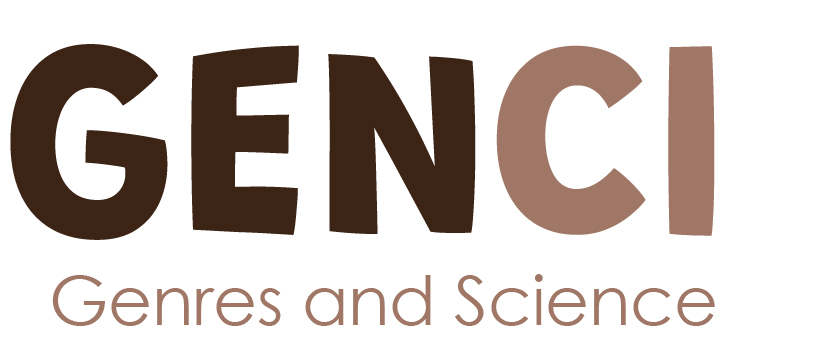On 28-29th September, the 9th Conference on Computer-Mediated Communication (CMC) and Social Media Corpora was held in Santiago de Compostela. Our team members Oana Carciu and Rosana Villares presented part of their current research projects. The abstracts of their presentations are linked below.
Digital science communication beyond expert audiences: Exploring add-on genres in enhanced publications. Carciu,O.M.
Abstract
Against the background of increasing possibilities for research communication facilitated by the affordances of Internet technologies, academic journals have added-on several digital genres to articles online, what has been conceptualized as “enhanced publications”. Some popular add-on genres are graphical abstracts and podcasts (Pérez-Llantada, 2013, 2021), research highlights (Akbaş & Farnia, 2021) and author summaries (Breeze, 2016), among others. They all aim to enhance the article contents and increase the article impact by targeting more diversified audiences, by this means aligning with the open science agenda (Fecher and Friesike, 2014). Corpora facilitate empirical investigation of these genres that populate the ecosystem of research communication online. Building such specialized corpora, therefore, represents a relevant research focus in the digital humanities. This paper discusses critically the compilation of a corpus of add-on genres, namely highlights, plain language summaries, digests, and significance statements published in open access between 2019 and 2022. The topic of the scientific journals from which the texts have been collected relate to climate change, environmental sustainability, and health and well-being. A case study approach is adopted and WordSmith Tools 8.0 was used to extract and analyse corpus data. This paper has the following objectives: 1) to explain the corpus compilation criteria, steps, and procedure for compiling the corpus; and 2) to provide preliminary results from a set of case studies conducted to gain insight into what appears to be typical of each genre or discourse type. The initial exploration of the corpus showed that each add-on genre likely serves a particular communicative goal: highlights seem to be created to boost the article’s discoverability by search engines; plain language summaries explain contents in an accessible way; digests target non-scientists; and, finally, significance statements are genres for fellow scientists from other disciplines. The descriptive corpus statistics show that among the rhetorical strategies specific to these add-on genres are the use of evaluative language (e.g. important), or language resources associated with interpersonal meaning such as personal pronoun references with both an inclusive (e.g. importantly we know little about) and exclusive (e.g. we demonstrate the importance of) meaning. These findings allow us to better understand the lexico-grammatical patterns, semantic prosody, and rhetoric of enhanced publications as well as to trace features of interdiscursivity in these genres. Such work has implications for teaching how to enhance research articles online with these genres to communicate science to diverse audiences in the digital environment.
An exploratory multimodal discourse analysis of Twitter conference presentations. Villares, R.
Abstract
New science-making practices such as open science and collaborative science are part of the current social demands that scientists must meet for the democratization of science. Additionally, scientists nowadays can benefit from Web 2.0 to create, share, and re-use scientific knowledge and address audiences with different backgrounds, interests, and expectations (Engberg & Maier, 2015, Pérez-Llantada, 2021). As a result, we are witnessing today how scientific knowledge is transformed into a more-accessible discourse by means of discourse and linguistic strategies and, on the other hand, by drawing on the technological affordances of the web (Kuteeva & Mauranen, 2018; Luzón, 2017). The purpose of this study is to examine how academics disseminate science to expert and non-expert audiences using the Twitter microblogging platform. For doing so, I collected a small-scale corpus of 330 English-written tweets from an emerging digital genre, a Twitter Conference, in the field of linguistics held in 2020. I am interested in identifying the discursive strategies used by the authors to understand how scientific knowledge is recontextualized in the Twitter platform. Data were analyzed using AntConc v4.0.7 and corpus linguistics techniques (frequencies, n-grams, concordances) to contrast the findings to already identified features of Twitter discourse and academic writing by the literature (Biber & Gray, 2010, 2016; Hyland, 2010; Zappavigna, 2017). Preliminary research findings reveal that these texts show the typical features of written discourse, and rely heavily on exemplifications, and concreteness (economy of language). It also reveals the occasional use of some features especially frequent in academic spoken discourse that are used to create proximity with the reader (‘you’, interaction markers) and stress the authors’ voice (‘I/we/my’). Few instances of linguistic innovation seem to be employed, apart from the use of Twitter’s affordances and the combination of semiotic resources, especially text with graphic elements (emojis and images), with the communicative purpose of creating a friendly environment and explaining abstract theoretical concepts and results. It is believed that this combination of language and visual resources may respond to the need to enhance the author’s credibility as a scientist and to attract the audience’s attention and interest in the discussed topics. These findings are expected to contribute to the on-going debate around the construction of digital genres and exploitation of Web 2.0 affordances for science communication.
